The Cooling Effect and Its Stability in Urban Green Space in the Context of Global Warming: A Case Study of Changchun, China
Abstract
1. Introduction
- (1)
- To explore the impact of changes in the urban thermal environment on the UGSCE and SUGSCE.
- (2)
- To study the influencing factors and mechanisms of the UGSCE and SUGSCE and to determine which types of green space have a more stable cooling effect under global warming.
2. Materials and Methods
2.1. Study Area
2.2. Research Framework and Data Sources
2.3. Research Methods
2.3.1. Inversion of Land Surface Temperature
2.3.2. Quantification of the UGSCE and SUGSCE
- (1)
- Quantification of the UGSCE and SUGSCE on the regional scale
- (2)
- Quantification of the UGSCE and SUGSCE on the patch scale
2.3.3. Potential Factor Analysis
2.3.4. Mathematical Statistical Analysis
3. Results
3.1. Quantification of the UGSCE and SUGSCE on the Regional Scale
3.2. Quantification of the UGSCE and SUGSCE on the Patch Scale
3.3. Identifying the Factors Influencing UGSCE and SUGSCE
4. Discussion
4.1. Stability of UGSCE Under Different Temperature Conditions
4.1.1. Regional Scale
4.1.2. Patch Scale
4.2. Influencing Factors of UGSCE
4.3. Influencing Factors of SUGSCE
4.4. Planning Inspiration and Research Limitations
5. Conclusions
Author Contributions
Funding
Institutional Review Board Statement
Informed Consent Statement
Data Availability Statement
Conflicts of Interest
References
- Du, H.; Wang, D.; Wang, Y.; Zhao, X.; Qin, F.; Jiang, H.; Cai, Y. Influences of land cover types, meteorological conditions, anthropogenic heat and urban area on surface urban heat island in the Yangtze River Delta Urban Agglomeration. Sci. Total Environ. 2016, 571, 461–470. [Google Scholar] [CrossRef]
- Liu, X.; Huang, Y.; Xu, X.; Li, X.; Li, X.; Ciais, P.; Lin, P.; Gong, K.; Ziegler, A.D.; Chen, A.; et al. High-spatiotemporal-resolution mapping of global urban change from 1985 to 2015. Nat. Sustain. 2020, 3, 564–570. [Google Scholar] [CrossRef]
- Zittis, G.; Hadjinicolaou, P.; Fnais, M.; Lelieveld, J. Projected changes in heat wave characteristics in the eastern Mediterranean and the Middle East. Reg. Environ. Change 2016, 16, 1863–1876. [Google Scholar] [CrossRef]
- Hu, D.; Meng, Q.; Zhang, L.; Zhang, Y. Spatial quantitative analysis of the potential driving factors of land surface temperature in different “Centers” of polycentric cities: A case study in Tianjin, China. Sci. Total Environ. 2020, 706, 135244. [Google Scholar] [CrossRef] [PubMed]
- Meng, Q.; Gao, J.; Zhang, L.; Hu, X.; Qian, J.; Jancsó, T. Coupled cooling effects between urban parks and surrounding building morphologies based on the microclimate evaluation framework integrating remote sensing data. Sustain. Cities Soc. 2024, 102, 105235. [Google Scholar] [CrossRef]
- Aminipouri, M.; Knudby, A.J.; Krayenhoff, E.S.; Zickfeld, K.; Middel, A. Modelling the impact of increased street tree cover on mean radiant temperature across Vancouver’s local climate zones. Urban For. Urban Green. 2019, 39, 9–17. [Google Scholar] [CrossRef]
- Ballester, J.; Quijal-Zamorano, M.; Méndez Turrubiates, R.F.; Pegenaute, F.; Herrmann, F.R.; Robine, J.M.; Basagaña, X.; Tonne, C.; Antó, J.M.; Achebak, H. Heat-related mortality in Europe during the summer of 2022. Nat. Med. 2023, 29, 1857–1866. [Google Scholar] [CrossRef]
- Iungman, T.; Cirach, M.; Marando, F.; Barboza, E.P.; Khomenko, S.; Masselot, P.; Quijal-Zamorano, M.; Mueller, N.; Gasparrini, A.; Urquiza, J.; et al. Cooling cities through urban green infrastructure: A health impact assessment of European cities. Lancet 2023, 401, 577–589. [Google Scholar] [CrossRef]
- Tan, W.; Cai, M.; Sun, Y.; Chen, T. From land-based to people-based: Spatiotemporal cooling effects of peri-urban parks and their driving factors in China. Landsc. Urban Plan. 2025, 254, 105243. [Google Scholar] [CrossRef]
- Beele, E.; Aerts, R.; Reyniers, M.; Somers, B. Spatial configuration of green space matters: Associations between urban land cover and air temperature. Landsc. Urban Plan. 2024, 249, 105121. [Google Scholar] [CrossRef]
- Liu, H.; Huang, B.; Gao, S.; Wang, J.; Yang, C.; Li, R. Impacts of the evolving urban development on intra-urban surface thermal environment: Evidence from 323 Chinese cities. Sci. Total Environ. 2021, 771, 144810. [Google Scholar] [CrossRef] [PubMed]
- Venter, S.Z.; Krog, H.N.; Barton, N.D. Linking green infrastructure to urban heat and human health risk mitigation in Oslo, Norway. Sci. Total Environ. 2020, 709, 136193. [Google Scholar] [CrossRef]
- He, B.J.; Wang, J.; Liu, H.; Ulpiani, G. Localized synergies between heat waves and urban heat islands: Implications on human thermal comfort and urban heat management. Environ. Res. 2021, 193, 110584. [Google Scholar] [CrossRef]
- Dugord, P.A.; Lauf, S.; Schuster, C.; Kleinschmit, B. Land use patterns, temperature distribution, and potential heat stress risk—The case study Berlin, Germany. Comput. Environ. Urban Syst. 2014, 48, 86–98. [Google Scholar] [CrossRef]
- Chakraborty, T.; Hsu, A.; Manya, D.; Sheriff, G. A spatially explicit surface urban heat island database for the United States: Characterization, uncertainties, and possible applications. ISPRS J. Photogramm. Remote Sens. 2020, 168, 74–88. [Google Scholar] [CrossRef]
- Xu, Y.; Yang, J.; Zheng, Y.; Li, W. Impacts of two-dimensional and three-dimensional urban morphology on urban thermal environments in high-density cities: A case study of Hong Kong. Build. Environ. 2024, 252, 111249. [Google Scholar] [CrossRef]
- Marando, F.; Heris, M.P.; Zulian, G.; Udías, A.; Mentaschi, L.; Chrysoulakis, N.; Parastatidis, D.; Maes, J. Urban heat island mitigation by green infrastructure in European Functional Urban Areas. Sustain. Cities Soc. 2022, 77, 103564. [Google Scholar] [CrossRef]
- Drake, J.E.; Tjoelker, M.G.; Vårhammar, A.; Medlyn, B.E.; Reich, P.B.; Leigh, A.; Pfautsch, S.; Blackman, C.J.; López, R.; Aspinwall, M.J.; et al. Trees tolerate an extreme heatwave via sustained transpirational cooling and increased leaf thermal tolerance. Glob. Change Biol. 2018, 24, 2390–2402. [Google Scholar] [CrossRef]
- Ibsen, P.C.; Santiago, L.S.; Shiflett, S.A.; Chandler, M.; Jenerette, G.D. Irrigated urban trees exhibit greater functional trait plasticity compared to natural stands. Biol. Lett. 2023, 19, 20220448. [Google Scholar] [CrossRef]
- Peng, J.; Dan, Y.; Yu, X.; Xu, D.; Yang, Z.; Wang, Q. Response of urban green space cooling effect to urbanization in the Three Ring Road area of Changsha City. Sustain. Cities Soc. 2024, 109, 105534. [Google Scholar] [CrossRef]
- Li, Y.; Svenning, C.J.; Zhou, W.; Zhu, K.; Abrams, J.F.; Lenton, T.M.; Ripple, W.J.; Yu, Z.; Teng, S.N.; Dunn, R.R.; et al. Green spaces provide substantial but unequal urban cooling globally. Nat. Commun. 2024, 15, 7108. [Google Scholar] [CrossRef]
- Zhang, Y.; Ge, J.; Wang, S.; Dong, C. Optimizing urban green space configurations for enhanced heat island mitigation: A geographically weighted machine learning approach. Sustain. Cities Soc. 2025, 119, 106087. [Google Scholar] [CrossRef]
- Liu, F.; Liu, J.; Zhang, Y.; Hong, S.; Fu, W.; Wang, M.; Dong, J. Construction of a cold island network for the urban heat island effect mitigation. Sci. Total Environ. 2024, 915, 169950. [Google Scholar] [CrossRef] [PubMed]
- Algretawee, H.; Rayburg, S.; Neave, M. Estimating the effect of park proximity to the central of Melbourne city on Urban Heat Island (UHI) relative to Land Surface Temperature (LST). Ecol. Eng. 2019, 138, 374–390. [Google Scholar] [CrossRef]
- Zhou, Y.; Zhao, H.; Mao, S.; Zhang, G.; Jin, Y.; Luo, Y.; Huo, W.; Pan, Z.; An, P.; Lun, F. Studies on urban park cooling effects and their driving factors in China: Considering 276 cities under different climate zones. Build. Environ. 2022, 222, 109441. [Google Scholar] [CrossRef]
- Zhou, Y.; Luo, Y.; Yi, X.; Lun, F.; Hu, Q.; Huang, N.; Wen, G.; Zhou, H.; Hu, X. Exploring the influence of local urban heat features on park cooling effects: Insights from Chinese cities. Build. Environ. 2024, 262, 111782. [Google Scholar] [CrossRef]
- Yu, Q.B.; Cao, L.J.; Li, Z.; Wang, C.C.; Zhang, Y.B.; Zhu, Y.N.; Wang, L.L. Multi-scale Temporal Variation Characteristics of Extreme Temperature in Changchun during 1909−2021 and Its Relationship with Large-Scale Climate Indices. Clim. Environ. Stud. 2023, 28, 437–449. [Google Scholar]
- Feng, Z.X.; Wang, S.J.; Jin, S.H.; Yang, J. Effects of urban morphology and wind conditions on land surface temperature in Changchun. Acta Geogr. Sin. 2019, 74, 902–911. [Google Scholar]
- Yang, C. The effect of the urban spatial structure on the spatio-temporal patterns of the urban thermal environment. Acta Geod. Cartogr. Sin. 2022, 51, 788. [Google Scholar] [CrossRef]
- Yang, M.; Nie, W.; Wu, R.; Yan, H.; Tian, S.; Wang, K.; Shi, L.; Cheng, X.; Ji, T.; Bao, Z. Towards more equitable cooling services of urban parks: Linking cooling effect, accessibility and attractiveness. J. Environ. Manag. 2024, 370, 122475. [Google Scholar] [CrossRef]
- Cook, M.J. Atmospheric Compensation for a Landsat Land Surface Temperature Product. Ph.D. Thesis, Rochester Institute of Technology, Rochester, NY, USA, 2014. Available online: http://scholarworks.rit.edu/theses/8513 (accessed on 18 March 2024).
- Sun, R.; Chen, L. Effects of green space dynamics on urban heat islands: Mitigation and diversification. Ecosyst. Serv. 2017, 23, 38–46. [Google Scholar] [CrossRef]
- Cai, Y.; Chen, Y.; Tong, C. Spatiotemporal evolution of urban green space and its impact on the urban thermal environment based on remote sensing data: A case study of Fuzhou City, China. Urban For. Urban Green. 2019, 41, 333–343. [Google Scholar] [CrossRef]
- Yu, Z.; Yao, Y.; Yang, G.; Wang, X.; Vejre, H. Spatiotemporal patterns and characteristics of remotely sensed region heat islands during the rapid urbanization (1995–2015) of Southern China. Sci. Total Environ. 2019, 674, 242–254. [Google Scholar] [CrossRef]
- Yan, L.; Jia, W.; Zhao, S. The Cooling Effect of Urban Green Spaces in Metacities: A Case Study of Beijing, China’s Capital. Remote Sens. 2021, 13, 4601. [Google Scholar] [CrossRef]
- Altman, D.G.; Bland, J.M. Standard deviations and standard errors. BMJ 2005, 331, 903. [Google Scholar] [CrossRef] [PubMed]
- Riemann, L.B.; Lininger, R.M. Principles of Statistics. Clin. Sports Med. 2018, 37, 375–386. [Google Scholar] [CrossRef] [PubMed]
- Gerace, A.; Montanaro, M. Derivation and validation of the stray light correction algorithm for the thermal infrared sensor onboard Landsat 8. Remote Sens. Environ. 2017, 191, 246–257. [Google Scholar] [CrossRef]
- Yang, C.; He, X.; Yu, L.; Yang, J.; Yan, F.; Bu, K.; Chang, L.; Zhang, S. The Cooling Effect of Urban Parks and Its Monthly Variations in a Snow Climate City. Remote Sens. 2017, 9, 1066. [Google Scholar] [CrossRef]
- Wang, L.; Jia, J.; Lu, Y.; Jing, Z.W.; Yao, Y.L. Dynamic Response of Green Space Configuration and Cooling Efficiency in Changchun City. Chin. Gard. 2022, 38, 44–49. [Google Scholar] [CrossRef]
- Liao, W.; Guldmann, J.M.; Hu, L.; Cao, Q.; Gan, D.; Li, X. Linking urban park cool island effects to the landscape patterns inside and outside the park: A simultaneous equation modeling approach. Landsc. Urban Plan. 2023, 232, 104681. [Google Scholar] [CrossRef]
- Li, X.; Zhou, W. Optimizing urban greenspace spatial pattern to mitigate urban heat island effects: Extending understanding from local to the city scale. Urban For. Urban Green. 2019, 41, 255–263. [Google Scholar] [CrossRef]
- Li, X.; Zhou, W.; Ouyang, Z.; Xu, W.; Zheng, H. Spatial pattern of greenspace affects land surface temperature: Evidence from the heavily urbanized Beijing metropolitan area, China. Landsc. Ecol. 2012, 27, 887–898. [Google Scholar] [CrossRef]
- Liu, H.Q.; Huete, A. A feedback based modification of the NDVI to minimize canopy background and atmospheric noise. IEEE Trans. Geosci. Remote Sens. 1995, 33, 457–465. [Google Scholar] [CrossRef]
- Peng, Y.; He, G.J.; Zhang, Z.M.; Yin, R.Y. Landsat Spectral Index Products over Qinghai-Xizang Plateau. China Scientific Data, pp. 1–8. Available online: https://kns-cnki-net.webvpn.ybu.edu.cn/kcms/detail/11.6035.N.20241031.1720.002.html (accessed on 28 January 2025).
- Weisberg, S. Applied Linear Regression, 3rd ed.; John Wiley & Sons, Inc.: Hoboken, NJ, USA, 2005. [Google Scholar]
- Zhang, Q.; Zhou, D.; Xu, D.; Rogora, A. Correlation between cooling effect of green space and surrounding urban spatial form: Evidence from 36 urban green spaces. Build. Environ. 2022, 222, 109375. [Google Scholar] [CrossRef]
- Du, H.; Cai, W.; Xu, Y.; Wang, Z.; Wang, Y.; Cai, Y. Quantifying the cool island effects of urban green spaces using remote sensing Data. Urban For. Urban Green. 2017, 27, 24–31. [Google Scholar] [CrossRef]
- Lu, Q.; Qi, W.; Yang, D.; Zhang, M. The influence of internal spatial coupling characteristics of blue-green space on cooling benefit in metropolitan areas: Evidence form Hangzhou, China. Environ. Sustain. Indic. 2025, 25, 100558. [Google Scholar] [CrossRef]
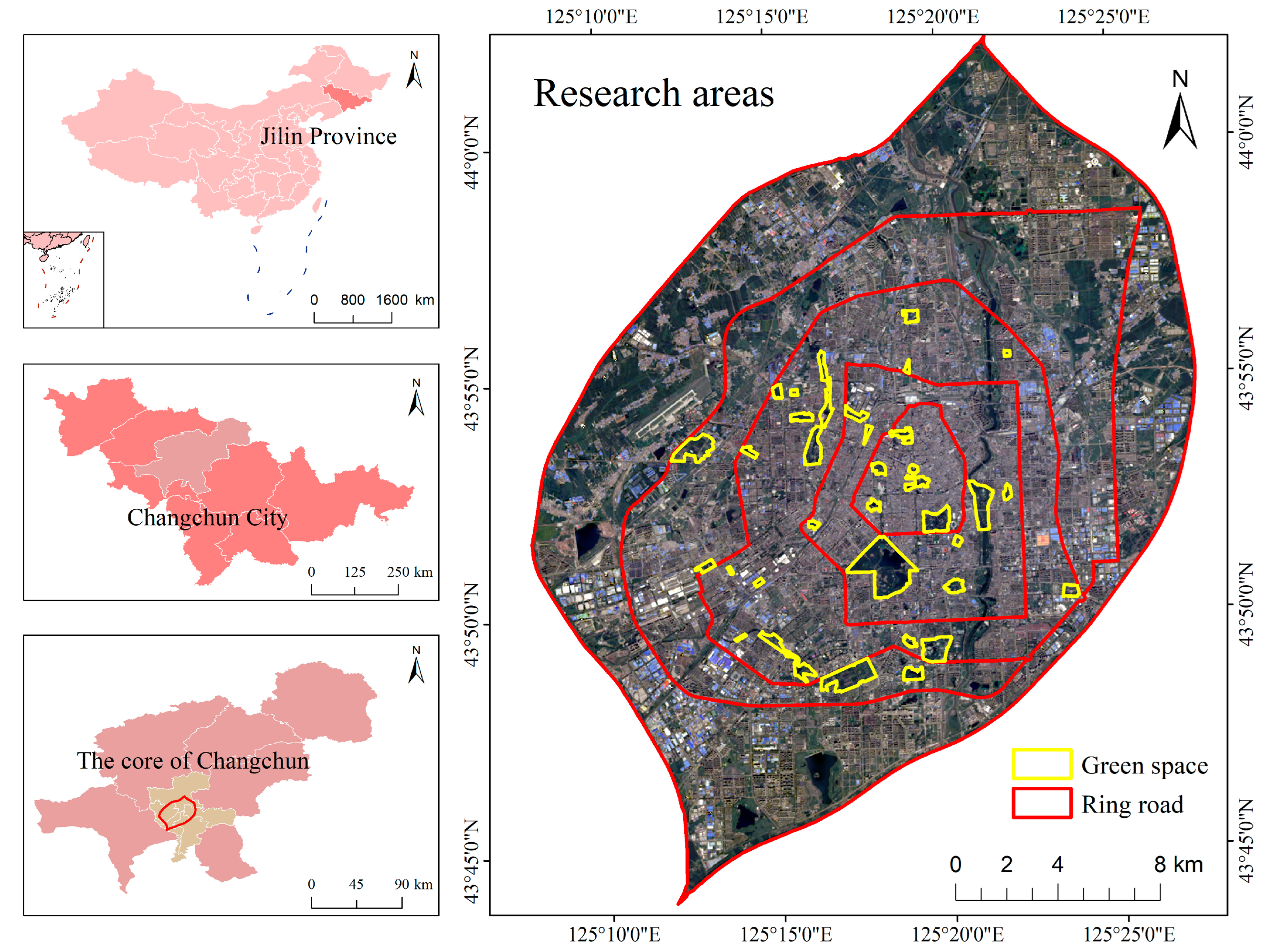
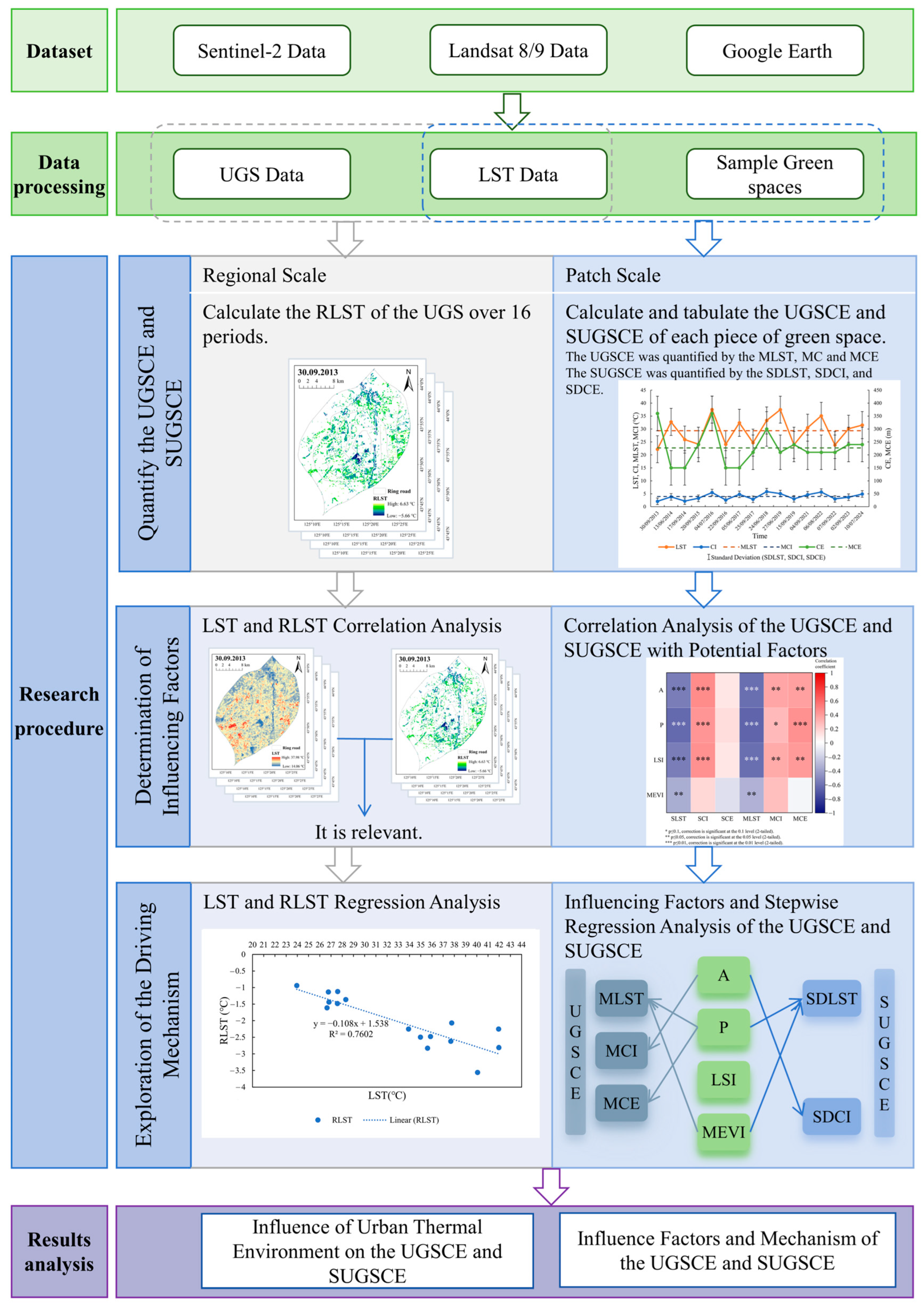

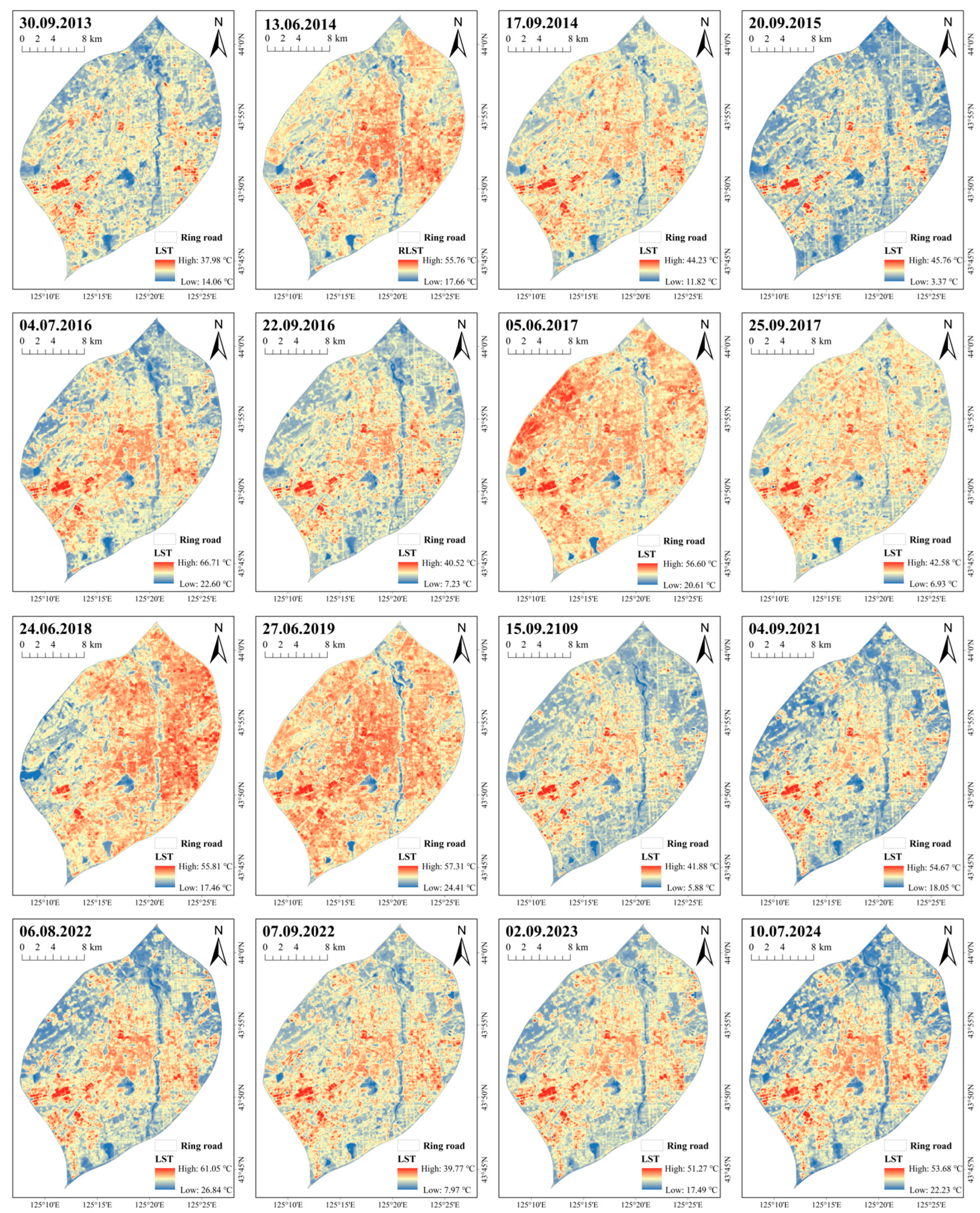

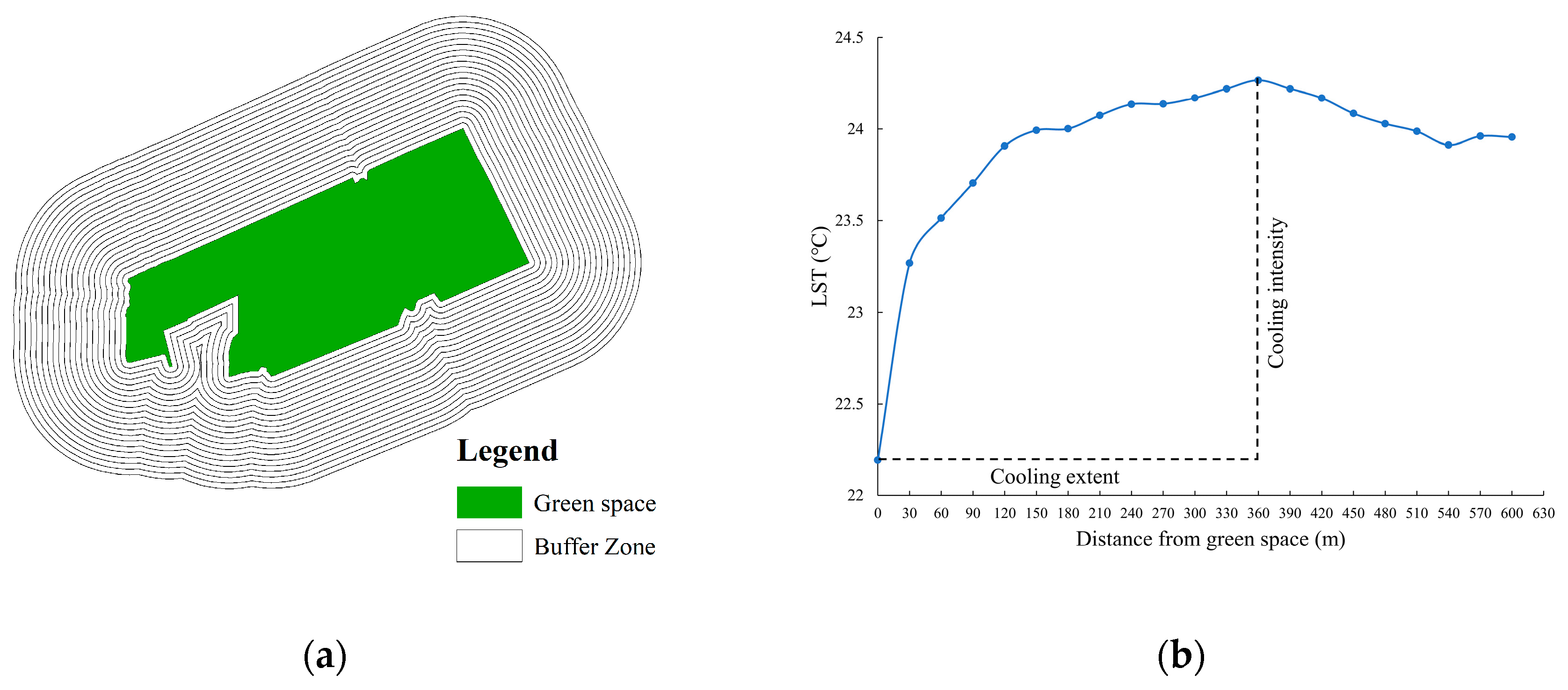
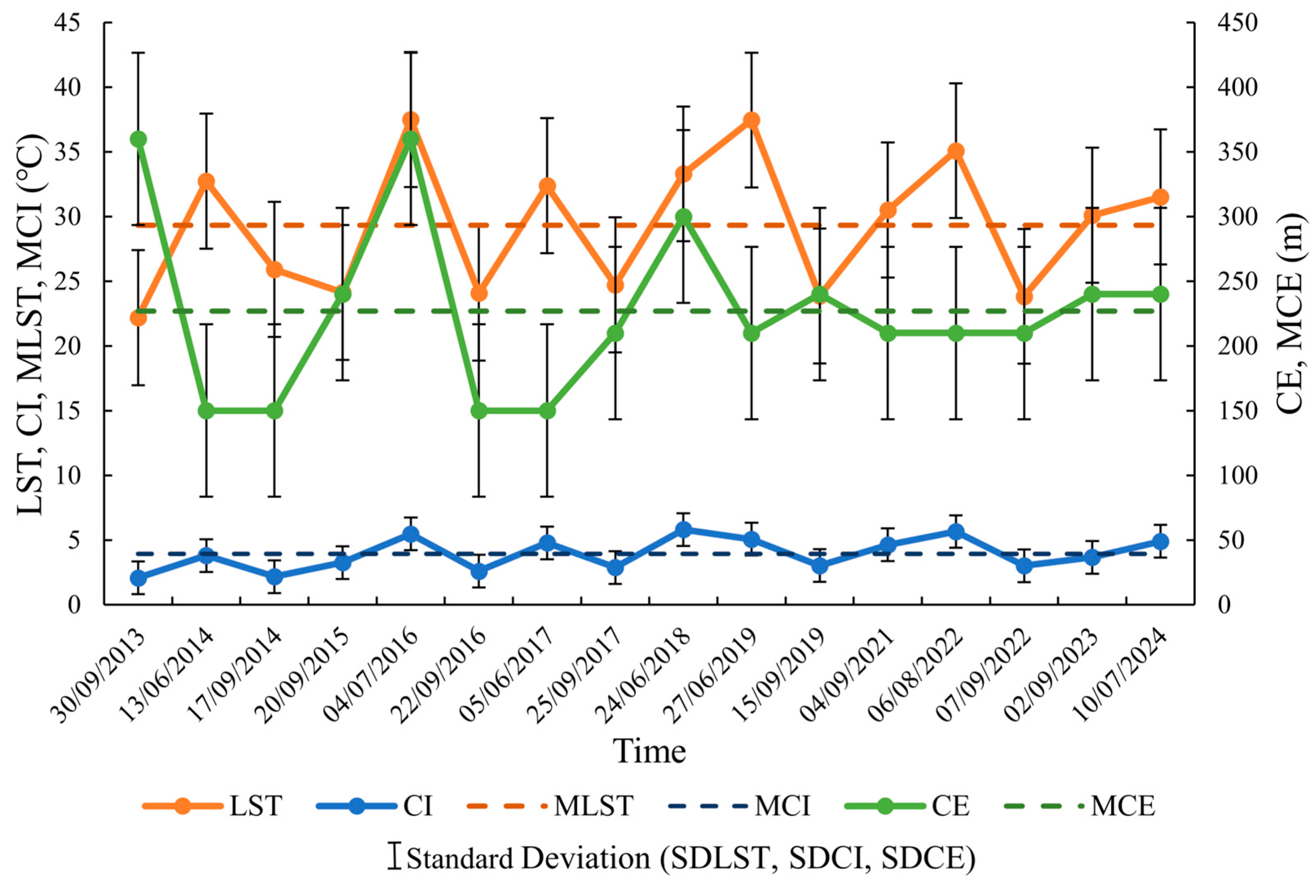
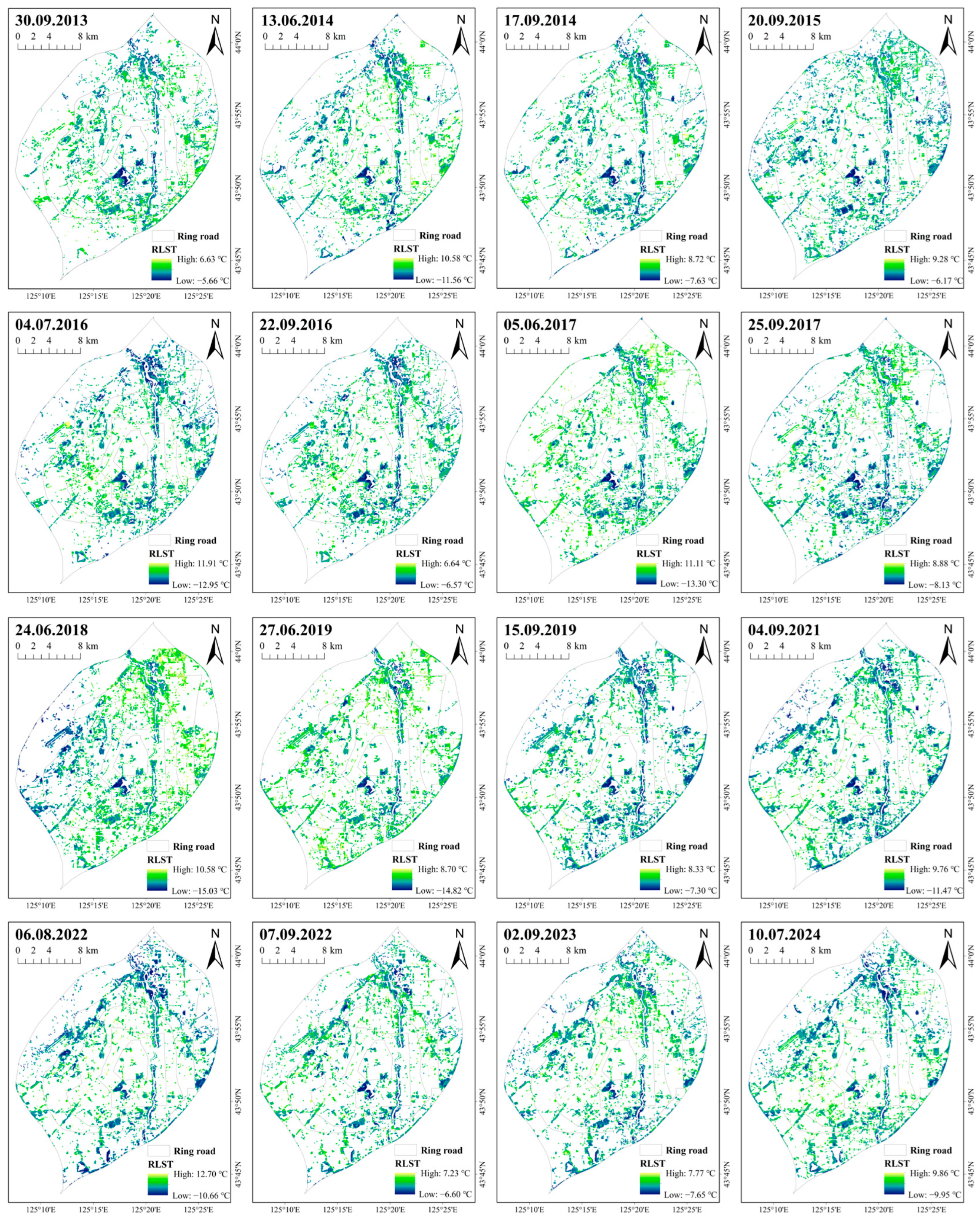
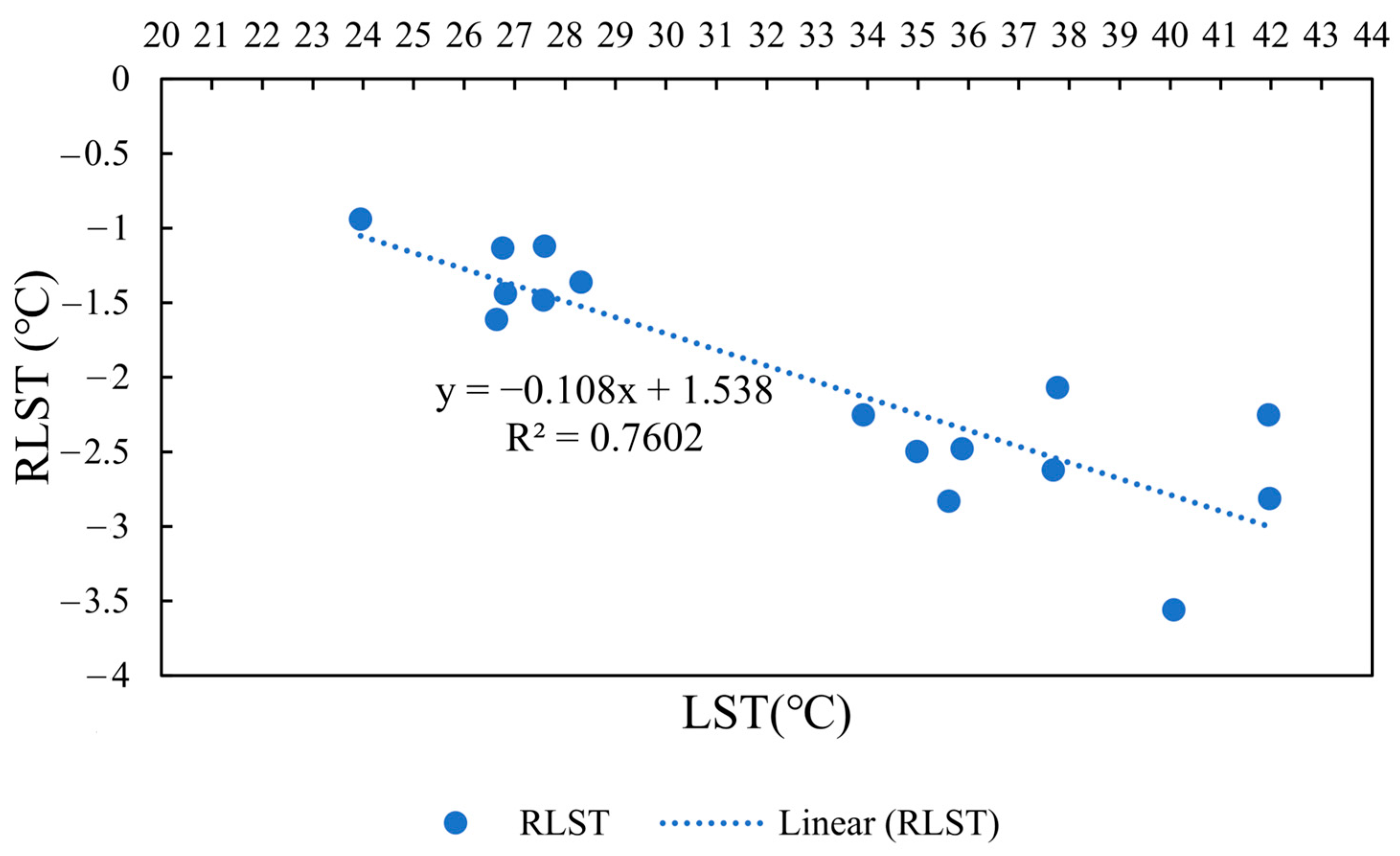
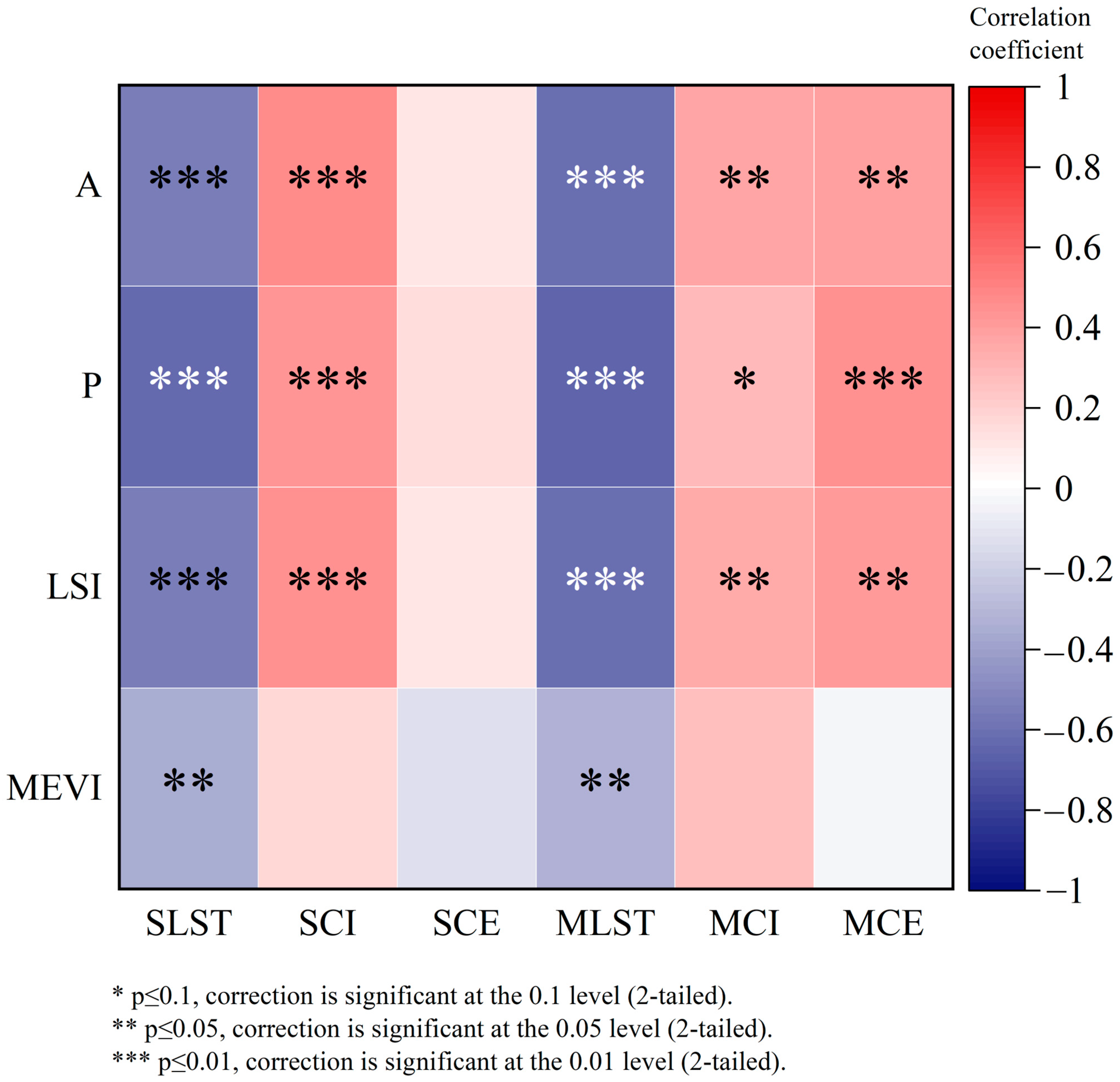
| Quantitative Indicator | Abbreviation |
|---|---|
| UGSCE | |
| Mean LSTs for green space phase 16 | MLST |
| Mean CIs for green space phase 16 | MCI |
| Mean CEs for green space phase 16 | MCE |
| SUGSCE | |
| Standard deviation of LST for green space phase 16 | SDLST |
| Standard deviation of CI for green space phase 16 | SDCI |
| Standard deviation of CE for green space phase 16 | SDCE |
| Factor | Abbreviation | Formula | Description |
|---|---|---|---|
| Area of green space | A | - | The area of each green space. |
| Perimeter of green space | P | - | The perimeter of each green space. |
| Landscape shape index | LSI | A standardized measure of edge density adjusting for the size of green space and a standard circle. P and A refer to the perimeter and area of each green space, separately [35]. | |
| Mean enhanced vegetation index (EVI) of green space | MEVI | EVI is based on the normalized difference vegetation index, which includes background adjustment parameters and atmospheric correction parameters to reduce background and atmospheric disturbances [44,45]. The mean EVI was calculated using the data from the 16th phase of the green space. |
| RLST | |
|---|---|
| LST | −0.872 *** |
| Name | Sample Size | Minimum Value | Maximum Value | Mean Value | Standard Deviation | Standard Errors |
|---|---|---|---|---|---|---|
| MLST | 35 | 27.41 | 33.14 | 30.57 | 1.33 | 0.22 |
| MCI | 35 | 1.83 | 6.85 | 4.18 | 1.16 | 0.2 |
| MCE | 35 | 110.63 | 301.88 | 173.95 | 56.01 | 9.5 |
| SDLST | 35 | 4.68 | 6.32 | 5.48 | 0.43 | 0.07 |
| SDCI | 35 | 0.47 | 2.24 | 1.35 | 0.38 | 0.06 |
| SDCE | 35 | 7.5 | 131.68 | 51.55 | 38.5 | 6.5 |
| Name | Sample Size | Minimum Value | Maximum Value | Mean Value | Standard Deviation | Standard Errors |
|---|---|---|---|---|---|---|
| A | 35 | 3.06 | 330.40 | 38.90 | 60.57 | 10.24 |
| P | 35 | 0.79 | 8.55 | 2.64 | 1.73 | 0.29 |
| LSI | 35 | 1.23 | 137.69 | 17.20 | 25.95 | 4.39 |
| MEVI | 35 | 0.26 | 0.45 | 0.35 | 0.05 | 0.01 |
| Quantitative Indicator for UGSCE | MLST | MCI | MCE | |
|---|---|---|---|---|
| Influencing Factors | A | 0.007 ** | ||
| P | −0.507 *** | 14.354 *** | ||
| LSI | ||||
| MEVI | −9.612 *** | |||
| R2 | 0.550 | 0.138 | 0.196 | |
| Regression model | MLST = 35.239 − 0.507 × P − 9.612×MEVI | MCI = 3.898 + 0.007 × A | MCE = 136.076 + 14.354 × P | |
| Quantitative Indicator for SUGSCE | SDLST | SDCI | |
|---|---|---|---|
| Influencing Factors | A | 0.003 *** | |
| P | −0.159 *** | ||
| LSI | |||
| MEVI | −3.213 *** | ||
| R2 | 0.540 | 0.217 | |
| Regression model | SDLST = 7.009 − 0.159 × P − 3.213 × MEVI | SDCI = 1.237 + 0.003 × A | |
Disclaimer/Publisher’s Note: The statements, opinions and data contained in all publications are solely those of the individual author(s) and contributor(s) and not of MDPI and/or the editor(s). MDPI and/or the editor(s) disclaim responsibility for any injury to people or property resulting from any ideas, methods, instructions or products referred to in the content. |
© 2025 by the authors. Licensee MDPI, Basel, Switzerland. This article is an open access article distributed under the terms and conditions of the Creative Commons Attribution (CC BY) license (https://creativecommons.org/licenses/by/4.0/).
Share and Cite
Yu, H.; Piao, Y. The Cooling Effect and Its Stability in Urban Green Space in the Context of Global Warming: A Case Study of Changchun, China. Sustainability 2025, 17, 2590. https://doi.org/10.3390/su17062590
Yu H, Piao Y. The Cooling Effect and Its Stability in Urban Green Space in the Context of Global Warming: A Case Study of Changchun, China. Sustainability. 2025; 17(6):2590. https://doi.org/10.3390/su17062590
Chicago/Turabian StyleYu, Han, and Yulin Piao. 2025. "The Cooling Effect and Its Stability in Urban Green Space in the Context of Global Warming: A Case Study of Changchun, China" Sustainability 17, no. 6: 2590. https://doi.org/10.3390/su17062590
APA StyleYu, H., & Piao, Y. (2025). The Cooling Effect and Its Stability in Urban Green Space in the Context of Global Warming: A Case Study of Changchun, China. Sustainability, 17(6), 2590. https://doi.org/10.3390/su17062590





